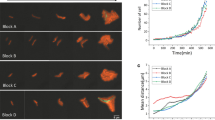Abstract
Most bacteria cells divide by binary fission which is part of a bacteria cell cycle and requires tight regulations and precise coordination. Fast separation of Staphylococcus Aureus (S. Aureus) daughter cells, named as popping event, has been observed in recent experiments. The popping event was proposed to be driven by mechanical crack propagation in the peripheral ring which connected two daughter cells before their separation. It has also been shown that after the fast separation, a small portion of the peripheral ring was left as a hinge. In the article, we develop a fracture mechanics model for the crack growth in the peripheral ring during S. Aureus daughter cell separation. In particular, using finite element analysis, we calculate the energy release rate associated with the crack growth in the peripheral ring, when daughter cells are inflated by a uniform turgor pressure inside. Our results show that with a fixed inflation of daughter cells, the energy release rate depends on the crack length non-monotonically. The energy release rate reaches a maximum value for a crack of an intermediate length. The non-monotonic relationship between the energy release rate and crack length clearly indicates that the crack propagation in the peripheral ring can be unstable. The computed energy release rate as a function of crack length can also be used to explain the existence of a small portion of peripheral ring remained as hinge after the popping event.







Similar content being viewed by others
References
Anderson TL (2017) Fracture mechanics: fundamentals and applications. CRC Press, Boca Raton
Egan AJ, Vollmer W (2013) The physiology of bacterial cell division. Ann N Y Acad Sci 1277:8–28
Gao Z, Gao Y (2016) Why do receptor-ligand bonds in cell adhesion cluster into discrete focal-adhesion sites? J Mech Phys Solids 95:557–574
Godin M et al (2010) Using buoyant mass to measure the growth of single cells. Nat Methods 7:387–390
Griffith AA (1921) The phenomena of rupture and flow in solids. Phil Trans R Soc Lond A 221:163–198
Hutchinson J, Paris P (1979) Stability analysis of J-controlled crack growth. Elastic-plastic fracture. ASTM STP 668:37–64
Liu Y, Gao Y (2015) Non-uniform breaking of molecular bonds, peripheral morphology and releasable adhesion by elastic anisotropy in bio-adhesive contacts. J R Soc Interface 12:20141042
Matias VR, Beveridge TJ (2007) Cryoc-electron microscopy of cell division in Staphylococcus aureus reveals a mid-zone between nascent cross walls. Mol Microbiol 64:195–206
Sakes A, van der Wiel M, Henselmans PW, van Leeuwen JL, Dodou D, Breedveld P (2016) PLoS ONE. Shooting mechanisms in nature: a systematic review 11:e0158277
Touhami A, Jericho MH, Beveridge TJ (2004) Atomic force microscopy of cell growth and division in Staphylococcus aureus. J Bacteriol 186:3286–3295
Treloar LRG (1975) The physics of rubber elasticity. Oxford University Press, Oxford
Tzagoloff H, Novick R (1977) Geometry of cell division in Staphylococcus aureus. J Bacteriol 129:343–350
Zhou X, Halladin DK, Rojas ER, Koslover EF, Lee TK, Huang KC, Theriot JA (2015) Mechanical crack propagation drives millisecond daughter cell separation in Staphylococcus aureus. Science 348:574–578
Zhou X, Halladin DK, Theriot JA (2016) Fast mechanically driven daughter cell separation is widespread in actinobacteria. mBio 7:e00952-16
Acknowledgements
S.C. acknowledges the support from Hellman Fellows Fund. Y.J. and Y.P.C. acknowledge the support from the National Natural Science Foundation of China (Grant Nos. 11572179, 11432008) and Tsinghua National Laboratory for Information Science and Technology.
Author information
Authors and Affiliations
Corresponding author
Ethics declarations
Conflict of interest
The authors declare that they have no conflict of interest.
Additional information
Publisher's Note
Springer Nature remains neutral with regard to jurisdictional claims in published maps and institutional affiliations.
Yuxuan Jiang and Xudong Liang have contributed equally to this work.
Rights and permissions
About this article
Cite this article
Jiang, Y., Liang, X., Guo, M. et al. Fracture mechanics modeling of popping event during daughter cell separation. Biomech Model Mechanobiol 17, 1131–1137 (2018). https://doi.org/10.1007/s10237-018-1019-6
Received:
Accepted:
Published:
Issue Date:
DOI: https://doi.org/10.1007/s10237-018-1019-6




